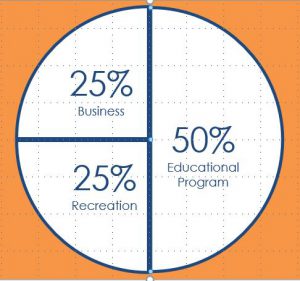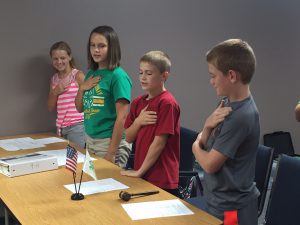The very word meeting makes me sigh and roll my eyes. I’ve been to so many that are a waste of time and energy and, let’s face it, boring! Are they ever really productive? Can’t they (please) be more interesting?
Meeting is just another word for get-together, assembly, encounter, engagement, rally or reunion. When 4-H Clubs follow the club meeting model, meetings can actually be fun! The 4-H Club meeting has three distinct parts: business, recreation and educational program. Business should take up 25% of the agenda, the educational program 50% and recreation 25% of your meeting time. The order of your 4-H Club meeting isn’t set in stone; club officers and leaders can be creative in how they set up the agenda for each club meeting.
 Dysfunction #1 – Adults Lead the Business Meeting
Dysfunction #1 – Adults Lead the Business Meeting
There’s no way around it; 4-H Clubs have business that needs to be dealt with including roll call, secretary and treasurer reports, committee reports, old and new business and announcements. It’s tempting for club leaders to take over and do this part of the meeting, but our youth learn nothing from this! Some of the most useful skills youth develop come from getting ready for the actual meeting and leading their peers in an organized setting, and as an adult, it’s really cool to see youth get things done efficiently. It’s also important to remember that business doesn’t have to be conducted at every 4-H Club meeting.
Dysfunction #2 – Skimping on the Educational Program
I’ve seen 4-H Club meetings that were literally 15 minutes long and consisted of only running through a business meeting. It made me cringe, and I know that 4-H parents were thinking the same thing as me… “Did I really leave my house for this?” “I could be sitting at my house in my PJ’s.” “I have three loads of laundry I should be folding.” “Is this all? It took me more time to drive here!” The educational program is the most important part of our 4-H Club meetings! After all, 4-H is in the business of providing high-quality educational experiences for its members, and those experiences can be pretty easy to pull together. Here are a few examples:
- 4-H Club members share what they’re doing with their projects.
- Invite a guest speaker.
- Take a short field trip.
- Show a video.
- Practice for judging contests or do a skill-a-thon.
- Create a fair project.
- Work on a community service project.
Dysfunction #3 – Forgetting the Fun
My co-worker, John Lilly, has a tag line on his email signature – Jefferson County 4-H is the place where there’s fun in learning and learning in fun! I firmly believe that the club that plays together stays together. Why? Because kids are going to want to come back, volunteers are going to stay engaged and most importantly, the parents will bring their kids back. Recreation helps kids make new friends and learn important social skills. Whether it’s through songs, ice-breakers, games, team-building activities or food, don’t forget to inject fun into 4-H meetings.
As a club member, leader or parent, you can help your 4-H Club avoid these three dysfunctions. Good 4-H Club meetings help youth make new friends, develop social skills, increase confidence and leadership and make decisions. To learn more about 4-H Club meetings, visit the florida4h.org and explore our Volunteer Training Series. The information here is great for club leaders but also for youth leaders and parents.
- Chick Chain Teaches Science and Workforce Ready Skills - March 17, 2023
- Are your Chickens Ready for Frigid Temps? - December 21, 2022
- Cultivating a Growth Mindset - August 11, 2022


